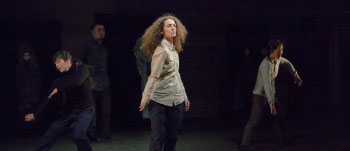Encountering (the other) as one human being
Korean choreographer Jung Youngdoo has created a piece based on what he felt in his travels to and from Korea and Fukuoka. He is collaborating with Korean artists from genres such as dance, theatre, art, music, film, and text, and they will perform in the style of a tour, with the performance venue being several places in the historical architecture of Kyushu University’s Hakozaki campus.
Data: March 23 (Sat) and 24 (Sun), 2013. Both performances start at 6pm.
Venue:
Kyushu University Hakozaki Campus (Fukuoka-shi Higashi-ku Hakozaki 6-10-1)
Meeting Point
Hakozaki University Entrance- “旧工学部本館入口” (Kyuu Kohgakubu Honkan Iriguchi)
HAKUBUTUKAN Anex#1
50SHUNEN MEMORIAL Auditrium- Faculty
50SHUNEN MEMORIAL Auditrium- Foyer
Performance Review of "baram"
Text: Shimada Eri
In a space that has been forgotten by people and continues to live on in the memory of someone, this performance silently, yet with a fever-heat, held that moment.
The stage was Kyushu University's Hakozaki Campus. The Korea- Japan Collaboration Program "baram" opened its Dance/Theatre/Film piece to the public on an evening in which the cherry blossoms approached full bloom earlier than in usual years.
Kyushu University's Museum (previously the intelligent machine lab-factory), nicknamed the machinery room, first took in the audience, which was full for both of the performance's two days. Purchased at the time of Kyushu University's establishment, it is a storehouse for old machinery used by students for experiments and research until the engineering department’s transfer to the Ito campus from 2005. Film arising in the dim storehouse and letters projected on the floor stated the beginning of the program.
At this time the dancers' confessions about themselves, moments in which they feel isolation and empathy, memories from dreams they've had, and the places they were raised in their childhood were projected. The dance was developed as if to overlap with that film, and since it aroused the audience's interest in the dancers, this served as the prologue to the performance.
Next, the audience moved inside the campus and was taken to the Memorial Auditorium. It was built as a memorial to 50th anniversary of Kyushu University which celebrated its 100th anniversary in 2011. Half a century from that occasion, this auditorium is utilized for Kyushu University's ceremonies and events. There is a cafeteria on the first floor, a place where students gather. In that auditorium, Miwa Tetsuzo's one-man show, the drama "Do you like wine?" was performed.
In this space we wander about the history relating to wine and the mentality of one sommelier in reality (the space we exist in). It certainly was "wandering," as we steadily fell into a mysterious intoxication while losing our bearings in that situation's transformations. Especially in the end scene, in which he showed his fear and anger towards the "white bellies" that always covered above the sommelier's head, seemed like it told the history of when a phantom fighter aircraft of U.S. Air Force crashed into the school grounds in 1968, and how airplanes always come flying over Kyushu University's Hakozaki campus even after Fukuoka airport became a civilian airport from 1972. (Currently, there are approximately 400 takeoffs and landings, with the international and domestic flights combined. The number of annual takeoffs and landings is 3rd in the country, after Haneda and Narita.)
Then finally, the dance "baram" by 7 dancers living in Fukuoka and South Korea was performed as the program's compilation.
It was composed as a dance with all 7 people, duets in which two people faced each other, and then again with everybody, in the auditorium hall in which 7 portraits painted by Tanaka Chisato were arranged. Amidst these dances I especially felt a tenderness and pleasantness in Duo Kong Youngsun and Cho Hyeoungjun's dance movements, which had a flowing lightness and flexibility. Then, the images of empathy and isolation in a group came across in the middle of expressing many physical movements and dance patterns. There, isolation and empathy shifted in an instant, and the intricate entanglement of the two emotions was felt, like they are empathizing with each other and they are isolated from each other, also. Furthermore, Park Jerok's music stimulated our emotions.
What comprehensive director Jung Youngdoo first thought at the start of this project was the question "After removing people's prejudices and preconceived notions, can't people encounter each other just as human being to human being without deciding about the other person from their background, such as that person's nationality or hometown?" However, I think that perhaps as the project progressed for roughly one year, it changed into the way of thinking that it is important to know the history of the other person in order to understand the other person. That way of thinking was not just towards people but also including the place that became the stage, and I understand this as the reason for which Jung Youngdoo personally carried out many interviews in Fukuoka and added diverse project members from various backgrounds such as text, dance, theatre, visual arts, and film.
I participated as a project member a little bit late, but I think that the dancers' words left the most lasting impression on me. Suenaga Claire, who has been living in Fukuoka for 19 years, learned the Japanese word for "isolation" for the first time through this project, and she said that the reason for this is that since it is a negative word, there was no one around her who uses it. At that moment, when she asked me what the english word is for what an isolated situation feels like, I answered "lonely," but now that I think about it, I feel like that is not enough. Amongst the inquiries to dancers about isolation, when I think over again the strong words of Lee Sunjin's "in this world, one decides while thinking by herself, she has to decide. I think that moment is isolation," or Ogata Yuka's "when the people one really loves, his parents or close friends, won't give him a push to do what he wants to do, he feels isolation," I thought that isolation is a word that makes me feel a strong determination, not necessarily negative, of a person being "alone" when he or she tries to accomplish something. Through this project, I feel like I learned the power words possess and the act of meeting people from Jung Youngdoo.
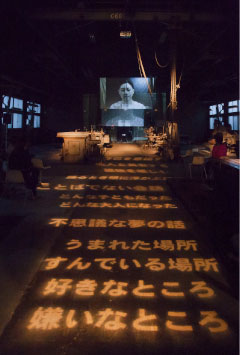
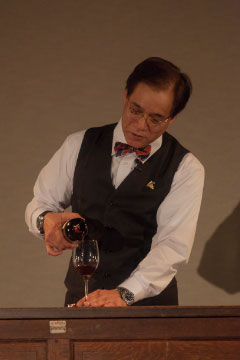
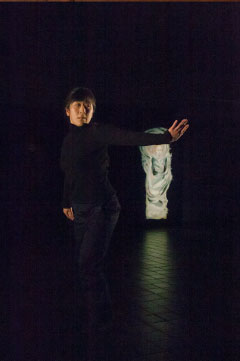
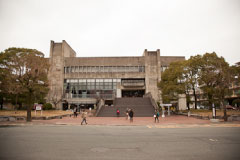
Text: Tsutui Aya
Summer, 2012.
This project started as the second round of JCDN's International Dance in Residence Exchange Project. The artist who came down to Fukuoka was Jung Youngdoo, who is active in Korea as a director and choreographer. It seems that at the beginning he was being conscious of "the unconscious of human beings" as seen through the historical relationship between South Korea and Japan. That is an extremely large theme due to its philosophical nature, including ideology, language, and nationality. As expected, it was to the extent that I felt unease about drawing near to the worldview expressing this director's vague impression.
He started from interviewing people from various standpoints and occupations, in various places such as the city ward office, university, artists, fishermen, and Zainichi Koreans (resident ethnic Koreans in Japan)- whatever came to mind. As if he were reeling in some invisible, fine thread. However, there was an encounter that gave a large guideline to his creation. It is Kyushu University, which is the venue for today's performance. Japan's history is engraved in old buildings. This is not only wonderful history. Kyushu University stands quietly, as if it were taking in everything, events that cause resentment and the sad past, also. At that time they were talking about how it looks like the land's thoughts or feelings dwell in the location. This project truly started after he decided to make this place the venue.
Winter, 2012.
When visiting Fukuoka in the summer, a workshop was held mainly for foreigners residing in Fukuoka. Pondering over the question "why can't people get to know each other as fellow human beings, in the true sense, without being conscious of nationality," Jung Youngdoo wanted to bring together as many foreigners as possible to the workshop. At this point he got another theme, which was that he wanted to make the piece with dancers from many different nationalities.
Dancers from Japan and England were selected at the audition for performers, he called upon a few dancers from South Korea, and 7 dancers possessing individuality and ability were decided. Furthermore, since he wanted to also try to make a theatrical piece, he underwent creation of a one-man show simultaneously. The decided cast members showed videos of their own dance styles after the audition, and he kept in contact with each of them while exchanging e-mails. At this point as well, the theme of the piece was still vague. However, "human beings' unconsciousness" was consistent from the start. Mother country and foreign country. No matter what, this borderline of the unconscious is on his mind, but a clear answer will not come out. While holding meeting, the staff was lost in thought, carefully looking for what is being illuminated upon and made visible in his head.
" Language" were a big wall. Most of the Japanese staff cannot speak Korean. The interviews also cannot go ahead without interpretation. From looking at the circumstances of the interviews, I wondered if what one really wants to say would be communicated to the other through interpretation. Won't there be differences in translation? Can one hear what one really wants to hear? However, that slight gap was filled by talking while looking at the facial expression of the other person. It seemed like looking at the other person in the eye when speaking to him or her communicates "something" to the each other, a "something" that cannot be relayed through words. No, not seemed, something definitely was communicated. Rather than using a multitude of words freely and trying to talk about something, there is a simpler method. I felt that sort of thing from his interviews. On top of that, I also felt that this was perhaps Yongdoo’s message to us. However, in order to present it as a piece, that is not enough. Facing a meager light far off in the distance, everyone involved in the project was still groping in the dark.
Spring, 2013.
At last, he stayed in Fukuoka full scale, and the creation started. The script for the one-man show was finished one month before the performance. From here he had to complete the theatrical piece and the dance piece. The practical creation work of the artistic staff, space designers, and filmmakers had to proceed at the same time, but there were many undecided matters. There was also a limit to the budget. Several ideas were put out in order to get closer to Jung Youngdoo's image, if even just a little. What pulled along the dance was the picture that Tanaka Chisato drew. Moreover, Tsuda Mitsuo handled the space design as an installation. As a thin trunk becomes rapidly bigger, the project's trunk was cultivated into a stable thing and became thicker as the participants increased one by one. Then, the staff and cast concentrated all of their energy in order to carry out only two performances.
The performance was produced like an excursion around the buildings of the campus, in the different images of the dance, theatre, and installations in each location. I felt that in theatrical pieces such as dance and theatre the existence of the venue (in what kind of place will one show the piece) always has a big influence on the observer, but precisely in the piece that was created in this project, everything, the performers and the space, united and left "something" in the hearts of the audience.
Jung Youngdoo says that he expressed at least a little of what he was conscious of at the beginning, such as language, ideology, and nationality, through the piece. However, I wonder if the project in its entirety, especially, is not in the form of the piece that he wanted to make. If I tried to explain it, I would say that he made two pieces: a piece called "baram" to show to the audience, and this project called "baram."
A research and an audition report during the Tsutui Aya review is here. >
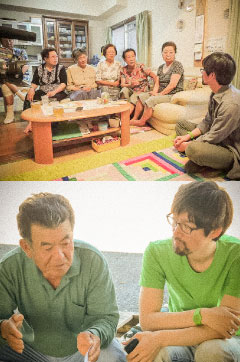
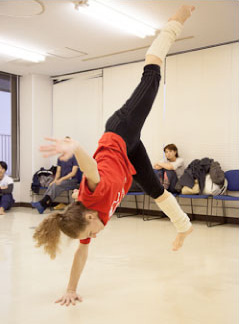
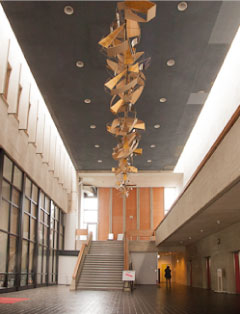
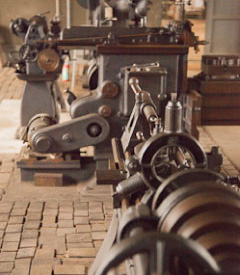
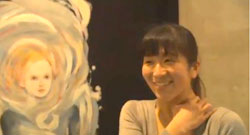
[Ogata Yuka]
Since the audition, I thought that I absolutely should not let this chance get away. What I can say through the beginning of rehearsals until the end is that I was too enthusiastic. But, something came into sight because I drove myself that far, and since it was my first experience dancing together with foreign dancers who have come to Japan, I really learned something. It was interesting, or rather, a challenge of how I would make use of my competitive spirit and engage in the performance.
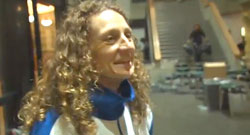
[Suenaga Claire]
I feel like, "hmm, what shall I do tomorrow?" The three weeks were very fun, and it's a bit sad that today is the end. I want it to be continued much more.
(What did you get from this project?)
There are a lot of different things. Of course there are the physical things, such as practice or technique, or how to enchant. And not only movement, but you also have to feel with the spiritual side. From that sort of point, it wasn't everyday, but I cried in these three weeks, and it was a very good experience especially because it was a really deep practice, and I could think about a variety of things. I am really thankful, and they let me be thankful. Thank you.

[Itoh Daisuke]
Let's see, usually I'm just doing things like dancing, but I really think I got a lot out of being able to stand in this place while being involved with film, theatre, and visual arts, and plus it was fun. Sometimes it was tough, but I could meet with a great group of people, and I really learned a lot of things from Jung Youngdoo. This is true for the performance as well, but more than anything I felt that I was really allowed to grow during the rehearsal period. Since I could learn about things relating to dance technique, of course, but also about a stance towards dance or a way of thinking, I thought that I hope I can keep that alive in myself from now on. Thank you.

[Matsui Eri]
Getting involved in this project, the first thing I felt was uneasiness, because I had doubts about how much of a thing we could make and how we would create a piece with people who can't communicate through same language, and since Japanese and Korean culture are completely different, I thought that perhaps what they do is also different. Rehearsals started and until halfway into creation, I would get irritated, and sometimes cried at home because I would be frustrated by not being able to do something. It was really good, even for myself, to be able to meet various people including the Korean people. I usually dance and think that I want to be enjoying it and have the audience enjoy it as well, but this time I danced while thinking about existing myself as a piece of art and exhibiting as a painting, not for the purpose of having the audience watch, which was the sense of atmosphere that Jung Youngdoo spoke of. I think that something good will be made if I still practice from now on, but at the last rehearsal today, while thinking about this painting and my own dance, I compared the two and got power from this painting. As for what I got out of this, there are so many things that I really can't count them all. The first thing is, when I dance... hm, I wonder what it is, that's difficult. Of course I have always had the idea to be myself when I dance, and I have been telling myself "be yourself," "be yourself" all along, but this time Young really pointed that out and said to me "It is good that there is sharpness in your dance, but it is stinging," and I was upset to get that advice because that was also my strong point within myself, but I was cautioned about it, and when I continuously tried to take the note, I was told by the people watching, " your dance has changed, huh," and so I was really glad about that. Sorry, this has gotten long.
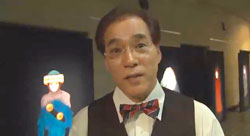
[Miwa Tetsuzo]
As for my impression after the performance, I hadn’t associated much with dance, or contemporary dance people before, but this time I watched the dance from the wings and thought it was really great. Jung Youngdoo's script and direction were more real, or perhaps I should say that it was a script that could make me more conscious of existing, and in that meaning of it I have had the privilege of having an incredibly good experience. I am really thankful to Young, and I am full of appreciation for everyone in this project. Thank you.
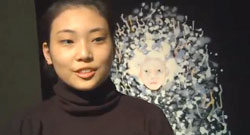
「Lee Sunjin」
This was my first time to stand on such a big stage, my stage debut so to speak, and my heart is really full because it was like I could dance a kind of dance that just fully made the best out of my "feelings" in a comfortable way, which is really different from the dancing I have been doing until now.
What I really learned is that my strong point is putting out energy. I figured out that is my strongest point. I was a dancer who knew the method of expressing the emotions inside of me. Therefore, since my dream has changed through this performance, I would like to become an even more wonderful dancer from now on.

「Cho Hyeoungjun」
My impressions after it`s over? First of all, well, it was tough. Everyone was really tired, but it was interesting. Since this is my first time to come here to Japan, I am really happy to have made Japanese friends. I think it was good to be able to make a piece together, putting my heart and all of my effort into it with good people. I could get that kind of thing.
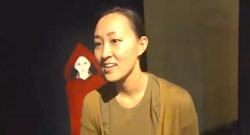
「Kong Youngsun」
Since it has finished... I have been thinking about my own personal things since it has finished, but I felt like the time I spent with everyone has arrived somewhere in the same way that an airplane made a landing. When I think of what the greatest thing I gained here was, I think it was friends. People... Yes, I think that was the best.
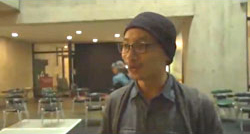
「Park Jerok」
I should say this in Korean, right? Now, I am relieved, since it has just finished. For now "I feel relieved on the one hand, sad on the other?" How can this be expressed in Japanese... I feel relieved on the one hand, sad on the other, and I feel like it should have been able to be done better,
Anyways, since I have come here, I have had the feeling that I have to make a good piece skillfully, and I have just been in that state all along. Even though I came to Fukuoka, I haven't been able to actually go sightseeing... That is really too bad, but I have to go back again tomorrow. I think that next time I would definitely like to come to Fukuoka again and also sightsee leisurely, and I would like to be able to meet everyone again.
Anyhow, since what remains now are the piece and the people who made it together, I would like to be able to have an opportunity to be able to meet with everyone again and if there is a chance to make a piece, I would like to be able to make a piece together again.
When I think of what I gained, it was "people" and "the piece." I hope that from now the piece will develop more, and that we can develop our relationships with each other by connecting more.
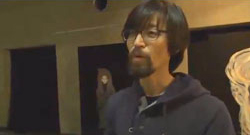
「Jung Youngdoo」
Somehow, since one year passed by very quickly, I feel a little regret because there was so much more to learn, but I enjoyed everyone moving and enjoying themselves in this way the most.
This project is still at the beginning point, and this is not the end.
While worrying more somehow, I feel a joy as if I, myself, have gained one more reason for continuing art. Thank you.






